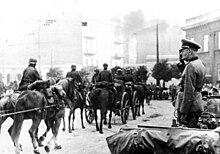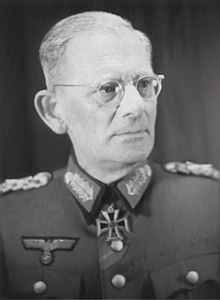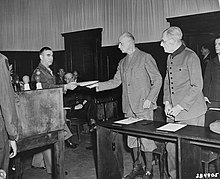Maximilian von Weichs

Maximilian Maria Joseph Karl Gabriel Lamoral Baron von und zu Weichs an der Glonn (born November 12, 1881 in Dessau ; † September 27, 1954 at Rösberg Castle in Bornheim - Rösberg ) was a German army officer (from 1943 Field Marshal General ) and during the Second World War Army and Army Group Commander in Chief.
Life
family
He came from the old Bavarian noble family Weichs and was the son of a ducal Anhalt head stable master and cavalry master . D. Weichs married Margarethe von Niesewand in 1928.
Bavarian Army
Weichs occurred after graduating from the Wilhelm Gymnasium München 1900 as a cadet in the 2nd Heavy Rider regiment "Archduke Franz Ferdinand of Austria-Este" of the Bavarian army in Landshut one. There he rose to lieutenant and was deployed as a regimental adjutant from 1905 to 1908. After Weichs had visited the equitation institute in Munich in 1908 , he graduated from the War Academy from 1910 to 1913 , which made him qualified for the general staff and departmental service. Weichs was then transferred to the central office of the General Staff and promoted to Rittmeister there in 1914.
At the outbreak of the First World War , Weichs was used as the commandant of the headquarters of the Cavalry Division and in October 1914 he was appointed Adjutant of the 4th Cavalry Brigade . In 1915 Weichs Ib became part of the 5th Infantry Division , and at the end of the war in 1918 he was on the staff of the Deputy General Command of the II Army Corps .
Weimar Republic
After the conclusion of the Versailles Treaty , Weichs was deployed in the staff of the Reichswehr Brigade 23 and from 1920 for three years as a general staff officer in the 3rd Cavalry Division in Kassel . In 1923, Weichs, meanwhile promoted to major , was squadron chief of the 18th cavalry regiment in Stuttgart-Cannstatt . He then worked as a tactics teacher at the infantry school in Ohrdruf until the end of January 1928 . From February 1, 1928, Weichs was a lieutenant colonel in command of the 18th Cavalry Regiment. On March 1, 1930, he became Chief of Staff of the 1st Cavalry Division in Frankfurt (Oder) . On November 1 of the same year he was made a colonel .
time of the nationalsocialism
Pre-war period

After Weichs was promoted to major general on April 1, 1933 and at the same time appointed Infantry Leader III in Potsdam , he was appointed commander of the 3rd Cavalry Division in Weimar in October 1933 .
In 1935, under Weichs' leadership, the 3rd Cavalry Division began to be transformed into the 1st Panzer Division . Weichs was promoted to lieutenant general in April 1935 , a year and a half later to general of the cavalry and after another year on October 12, 1937 to commanding general of the XIII. Army Corps and Military District XIII in Nuremberg .
In the spring of 1939, Weichs and his corps took part in the occupation of the rest of the Czech Republic.

Second World War
At the beginning of the Second World War during the attack on Poland , Weichs was still commanding general of the XIII. Army Corps and took part in the conquest of Warsaw in this position . In October 1939 he was appointed Commander in Chief of the 2nd Army and took part in the French campaign. After the fighting was over, Weichs was promoted to Colonel General on July 19, 1940 .
Weichs then took part in the Balkan campaign with the 2nd Army on April 10, 1941 and accepted the surrender of the Yugoslav army on April 16 .
At the beginning of the war against the Soviet Union on June 22, 1941, Weichs and his 2nd Army were deployed in the Association of Army Group Center . For the battle for Kiev the 2nd Army and Panzer Group 2 were temporarily turned to the south. In June 1942, Weichs was appointed commander-in-chief of an army group named after him, which was given the task of taking Voronezh . In mid-July 1942, instead of the deposed Fedor von Bock , he took over the leadership of the newly formed Army Group B , with which he was to carry out the Braunschweig operation , the advance to Stalingrad . After the success of the Soviet Operation Uranus in the Battle of Stalingrad , the southern part of his Army Group formed the new Army Group Don , which, however, was practically dismantled and disbanded by the Red Army counter offensives in the winter of 1942/43 . On February 1, 1943, Weichs was appointed General Field Marshal and in July 1943 was transferred to the Führer Reserve .
Already in August 1943 Weichs but was reactivated and Commander Southeast, while the OB of Army Group F appointed. During this time he was the recipient, reader and probably distributor of the sonnets by Reinhold Schneider , which his wife , who was a friend of Schneider's publisher Karl Borromäus Glock , sent him.
In autumn 1944 he organized the evacuation of Greece and Yugoslavia by German troops during the Soviet Belgrade operation, contrary to Hitler's orders , by presenting planned retreat movements in the situation reports to the OKW as being caused by enemy attacks.
On March 25, 1945, Weichs was finally transferred to the Führerreserve and taken prisoner by US units in Ettal in Bavaria on May 2, 1945 .
In the hostage murder trial , Weichs and other Wehrmacht officers were charged with murdering hundreds of thousands of civilians . The case against Weichs was discontinued because of his poor health and Weichs was released from prison.
Awards (selection)
- Iron Cross (1914) 2nd class, October 5, 1914
- Iron Cross 1st Class, November 13, 1915
- Knight's Cross of the Royal House Order of Hohenzollern with Swords, April 22, 1918
- Knight's Cross of the Iron Cross , June 29, 1940
- Knight's Cross of the Iron Cross with Oak Leaves, February 5, 1945.
literature
- Othmar Hackl : The Bavarian War Academy (1867-1914). CH Beck´sche publishing house bookstore. Munich 1989. ISBN 3-406-10490-8 . P. 598.
- Friedrich-Christian Stahl: Field Marshal General Maximilian Freiherr von und zu Weichs an der Glon. In: Gerd R. Ueberschär (ed.): Hitler's military elite. From the beginning of the war to the end of the world war. Volume 2. Primus. Darmstadt 1998. ISBN 3-89678-089-1 . Pp. 276-282.
Web links
- Robert Thoms: Maximilian von Weichs. Tabular curriculum vitae in the LeMO ( DHM and HdG )
Individual evidence
- ^ Annual report on the K. Wilhelms-Gymnasium in Munich. ZDB ID 12448436 , 1899/1900.
- ↑ Othmar Hackl: The Bavarian War Academy (1867-1914). CH Beck´sche publishing house bookstore. Munich 1989. ISBN 3-406-10490-8 . P. 598.
- ↑ Karl Borromäus Glock: "The risk - justification of a loner", experiences and maxims of a publisher ", 1975, ISBN 3-87354-0509 , pp. 61, 71
- ↑ Martin Zöller; Kazimirz Leszczyński Ed .: Case 7 - The hostage murder trial ruled by the United States Military Tribunal V. VEB Verlag der Wissenschaften, Berlin 1965, p. 58.
- ↑ Also on the following orders Johannes Hürter : Hitler's Army Leader. The German Commander-in-Chiefs in the War against the Soviet Union 1941/42 , Oldenbourg, Munich 2007, ISBN 978-3-486-57982-6 , p. 669 (accessed via De Gruyter Online).
| personal data | |
|---|---|
| SURNAME | Weichs, Maximilian von |
| ALTERNATIVE NAMES | Weichs an der Glon, Maximilian Maria Joseph Karl Gabriel Lamoral Reichsfreiherr von und zu (full name) |
| BRIEF DESCRIPTION | German Field Marshal General, Army Group Commander in World War II |
| DATE OF BIRTH | November 12, 1881 |
| PLACE OF BIRTH | Dessau |
| DATE OF DEATH | September 27, 1954 |
| Place of death | Bornheim - Rösberg |

